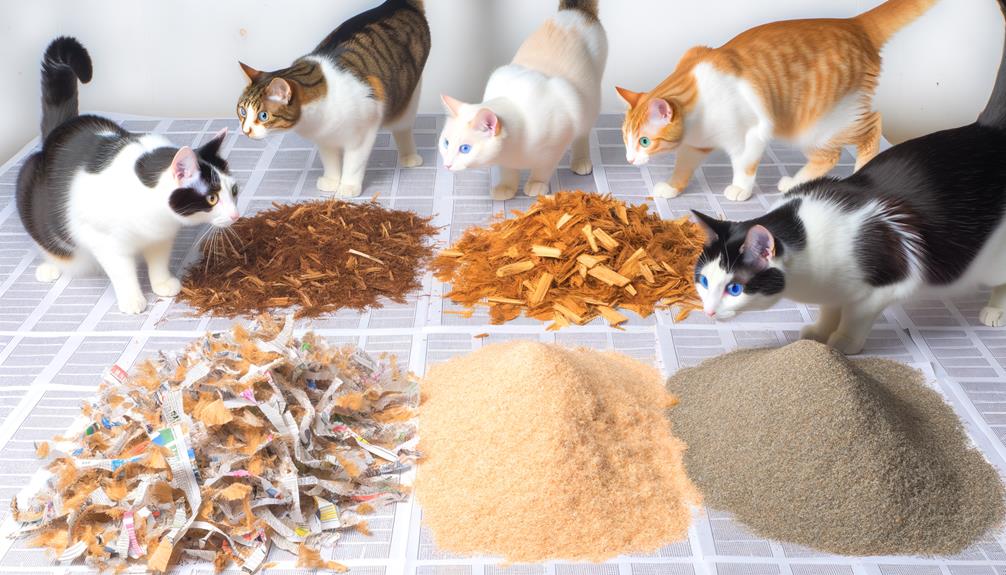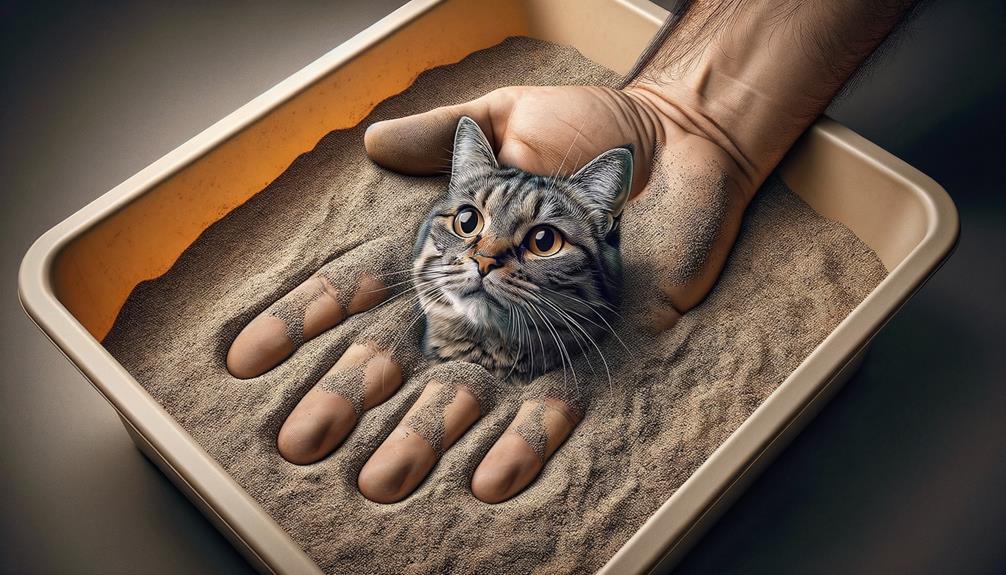Have you ever pondered the idea of using sand as cat litter? It's an affordable, natural alternative that could potentially save you a few pennies. Despite its cost-effectiveness, there are some drawbacks to consider, such as lack of odor control and possible health risks to your feline companion. Yet, with proper care, these issues may be managed effectively. You're probably wondering if the switch is worth the effort, right? Well, let's plunge into the pros and cons to help you make an informed decision.
Key Takeaways
- Sand can be used as cat litter due to its natural texture and ability to absorb urine.
- Play sand from home improvement stores is a safe and affordable option for cat litter.
- Sand may not effectively control odors and can pose health risks such as allergies and gastrointestinal issues.
- Transitioning to sand litter should be gradual, mixing it with current litter and monitoring the cat's adjustment.
- Maintenance of a sand litter box includes daily scooping, regular stirring, and replacing the entire box every 2-3 days.
Understanding Cat Litter Basics

Before you decide to use sand as cat litter, it's crucial to grasp the basics of cat litter and its role in a cat's life. Cat litter is an essential part of your feline friend's daily routine, offering a place for them to eliminate waste comfortably and hygienically.
Now, you've got to understand your cat's litter preferences. You see, cats are finicky creatures, and their litter preferences can vary widely. Some cats may prefer soft, sand-like textures, while others might favor larger, more granular materials. It's essential to pay attention to your cat's behaviour when introducing a new type of litter. If your cat avoids the litter box or shows signs of discomfort, it might be a clear indication that they're not fond of the new litter.
Let's touch on litter training next. Whether you're a seasoned cat parent or a newbie, litter training is a critical part of raising a cat. It involves teaching your cat to eliminate in a designated place – the litter box. Start this process as early as possible, and use positive reinforcement like treats or praise to encourage proper litter box usage. Remember, consistency is key during this process.
What Constitutes Cat Litter?
Now that you've got a handle on your cat's litter preferences and the importance of litter training, let's unpack what actually goes into the cat litter itself. The main component of any cat litter is what we call the litter material. Traditionally, this was usually a type of clay, specifically bentonite, which forms clumps when wet. This clumping ability makes it easy to scoop out and dispose of the cat's waste, so it's been a popular choice for many years.
However, litter innovations have led to a variety of other litter materials being used. These range from recycled paper and wood pellets, to more exotic options like coconut husk or walnut shells. Each of these has its own pros and cons. For instance, while wood pellets may be more environmentally friendly, they don't clump as well as clay, making waste disposal a bit more challenging.
It's also important to mention that many cat litters contain additional ingredients to help control odors. These can include baking soda, activated carbon, or even artificial fragrances. However, some cats and their owners may find these additional scents off-putting or irritating.
In the end, the best cat litter for you and your feline friend depends on a variety of factors. These include your cat's preferences, your cleaning habits, environmental considerations, and budget constraints. It's all about finding the right balance that works for you. And remember, no matter what litter materials you choose, the key is consistent and thorough cleaning.
The Idea of Using Sand

You might be wondering about the feasibility of using sand as cat litter, given its wide availability and low cost. It's not an outlandish idea. In fact, it's part of a larger movement towards sustainable alternatives to traditional products. You're not alone in your quest to find greener options for everyday tasks.
The idea of using sand as cat litter isn't new. Before commercial cat litters became available, people often used sand, dirt, or ashes in litter boxes. Sand, in particular, has certain characteristics that make it a potentially good choice. It's a natural material that cats may instinctively prefer, and it can absorb urine, though not as effectively as some commercial litters.
But not all sand is created equal. You might wonder about the suitability of beach sand, for instance. While it's certainly plentiful and free if you live near a beach, it's not the best choice. Beach sand can contain contaminants and microorganisms that could pose a health risk to your cat. Moreover, removing sand from beaches can contribute to coastal erosion, which is hardly a sustainable practice.
Instead, you'd need to look for clean, non-toxic sand, preferably from a renewable source. Play sand, which you can find at home improvement stores, is one option. It's typically washed and sterilized, making it safe for your cat.
Keep in mind that while sand can serve as a litter substitute, it may not perform as well as commercial litters in some respects. But we'll delve into that in the next section. For now, you've got a good grasp of the idea of using sand as cat litter.
Advantages of Sand as Litter
Diving into the perks, sand offers several advantages as a cat litter alternative. One of the key advantages lies in sand's affordability. You'll find that sand is significantly cheaper than most commercially available cat litters. It's not just about your wallet, though. Sand's affordability also means that you're more likely to change it more regularly, contributing to better hygiene for your feline friend.
Secondly, let's talk about the environmental impact. Traditional cat litter often ends in landfills, contributing to environmental pollution. However, using sand as a cat litter alternative is a more environmentally friendly option. Choosing sand over traditional cat litter reduces the amount of waste generated, as you're swapping a manufactured product for a natural resource.
Additionally, sand is an efficient odor absorber. It does a decent job at soaking up the unpleasant smells that come with cat ownership. Moreover, it's also easier to clean up, as waste tends to form clumps in sand, making it easier to scoop out.
Lastly, many cats seem to like using sand. The texture of sand is similar to that which cats would naturally use in the wild, making it a comfortable option for them. Cats are creatures of habit and any change can cause them stress, so finding a litter that they like can make a big difference in their overall wellbeing.
In short, using sand as cat litter can be beneficial to both you and the environment. It's affordable, eco-friendly, efficient at odor control, and potentially more comfortable for your cat.
Drawbacks of Sand as Litter

While sand might seem like a good idea for cat litter, it's not without its issues.
You've probably noticed that it's not quite up to par when it comes to controlling odors.
But more concerning is the potential health risks it could pose to your feline friend.
Health Risks for Cats
Despite its cost-effectiveness, using sand as cat litter can pose significant health risks to your feline friend. One of these risks includes feline allergies. Some cats can develop allergic reactions to the dust particles in sand, causing them discomfort or even respiratory issues.
Sand also poses a risk if your cat consumes it. Litter consumption can lead to gastrointestinal problems in cats, ranging from constipation to more serious conditions. Sand, being composed of small, hard particles, can be especially problematic if ingested.
Always monitor your cat's behavior while using sand as litter, and consult with your vet if you notice any changes. Remember, your cat's health should always come first.
Sand's Ineffective Odor Control
Another significant downside of using sand as cat litter is its poor odor control, leaving your home with a less than pleasant smell. Unlike specially designed cat litters, sand doesn't effectively mask or neutralize the stench of cat waste. This problem is even worse with beach sand usage because of its inherent dampness, which can intensify odors.
You might also worry about sand allergies. Sand can contain allergens that trigger reactions in both you and your furry friend. Symptoms range from sneezing to severe respiratory distress. It's a risk you don't need to take. So, while sand may seem like a budget-friendly alternative, its inability to control odors and potential allergen issues make it less desirable as a cat litter substitute.
Sand Types Suitable for Litter
You might be wondering which types of sand are best suited for use as cat litter. When considering sand's environmental impact and affordability, two types come to mind: play sand and all-purpose sand.
Play sand is the type you'd typically find in children's sandboxes. It's fine-grained, soft, and dust-free, making it an acceptable substitute for regular cat litter. It's also relatively cheap, so you won't have to break the bank to keep your cat's litter box filled. As for its environmental impact, it's a natural product that's often made from crushed rock, so it doesn't contribute to pollution or waste.
All-purpose sand, on the other hand, is a bit coarser than play sand, but it's still suitable for use as cat litter. It's a little pricier, but it's also more durable and lasts longer, so you might find that it's more cost-effective in the long run. When it comes to the environment, all-purpose sand is also a natural product, so it has the same benefits as play sand.
However, it's important to remember that while these types of sand may be suitable for use as cat litter, they mightn't be the best choice for your feline friend. Sand doesn't clump like traditional cat litter, and it can be messy to clean up. You'll also need to change it more often to keep your cat's litter box fresh and clean, which could offset any savings you might see from the lower cost.
Health Risks Associated With Sand

You mightn't be aware, but using sand as cat litter can pose some health risks.
One significant concern is the potential for bacterial contamination, which can harm both you and your feline friend.
Moreover, the sand can lead to respiratory issues and may even act as a medium for parasite transmission.
Sand's Bacterial Contamination Risk
While using sand as cat litter might seem economical and natural, it's important to consider the potential health risks, such as bacterial contamination. Sand sourcing concerns often revolve around where and how the sand is collected. It could contain harmful bacteria or parasites if it's gathered from contaminated areas, putting your cat and even your family at risk.
Sand disposal methods also play a part in this issue. If you're not properly disposing of used sand, it could lead to a build-up of harmful bacteria in your home. For example, simply dumping it in your garden might introduce harmful organisms into your soil.
Respiratory Issues From Sand
In addition to bacterial concerns, sand as cat litter could cause respiratory problems, posing another health risk. Sand, especially when disturbed by your cat's digging, can produce a lot of dust. This dust can easily be inhaled, leading to lung irritation and potentially triggering sand allergies. Both you and your pet are at risk.
Breathing in sand dust can cause coughing, wheezing, and shortness of breath, symptoms that shouldn't be taken lightly. Although there are dust mitigation strategies, they're often not completely effective. Sand particles are tiny and can still be airborne despite your best efforts. Therefore, while sand might seem a viable alternative to traditional cat litter, it's crucial to consider these potential health hazards.
Sand's Parasite Transmission Potential
Beyond respiratory issues, sand cat litter could also ramp up the risk of parasite transmission, posing another significant health threat to both you and your feline friend. Parasites, particularly those with a life cycle involving soil or sand, could thrive in a sand-based litter box. Your cat's close contact with the infected sand could lead to ingestion of parasite eggs, resulting in a myriad of health issues.
Furthermore, some of these parasites may cause zoonotic diseases, illnesses that can jump from animals to humans. You could unknowingly come into contact with the contaminated sand while cleaning the litter box and get infected. Therefore, it's crucial to consider these health risks before switching to sand as your cat's litter.
Comparing Sand to Commercial Litter

You might be wondering how sand stacks up against commercial cat litter, so let's dive into the comparison.
One key point to consider is sand sourcing. Unlike commercial cat litter, which you can easily buy from any pet store, sourcing sand might be a bit more challenging. If you're considering using beach sand, remember that it's not only illegal in many places to remove sand but it's also not sanitary due to potential contamination with harmful bacteria or parasites.
Commercial litters are produced with your pet's safety in mind, going through rigorous quality checks to ensure they're free from harmful substances. They're also designed to absorb moisture and control odors, benefits that sand doesn't necessarily provide. Even if you're thinking about using play sand or construction sand, you'll still need to sift it yourself to get rid of any large particles or debris, which can be time-consuming.
Now, let's talk about litter disposal. Most commercial cat litters are designed for easy disposal. Clumping litters, for example, allow you to scoop out and throw away waste without having to replace the entire litter box contents. Sand, on the other hand, doesn't clump around waste, making it harder to remove soiled parts. This means you'll likely need to replace the entire contents of the litter box more frequently, which could lead to higher sand usage and, potentially, more waste.
In comparison to commercial litter, using sand may involve more effort in sourcing and disposing of it. Consider these factors when deciding what's best for you and your feline friend.
Practicality of Sand Litter
You might be wondering about the practicality of using sand as cat litter.
Let's consider the highs and lows of this alternative.
We'll look at both the advantages and the limitations to give you a clear picture.
Sand Litter Advantages
There are several practical benefits to using sand as cat litter that make it an attractive option for many cat owners. One of the prime benefits lies in sand sourcing options. You can easily find sand at most hardware stores, pet shops, and even in your own backyard. This abundance and accessibility make sand a readily available and convenient choice for cat litter.
Another major advantage is the cost-effectiveness of sand. When you do a cost effectiveness analysis, sand stands out as an economical option compared to traditional cat litter. It's cheaper and lasts longer, which means less frequent replacements. So, not only does sand save you money, but it also saves you time. This combination of convenience and affordability makes sand an appealing cat litter alternative.
Sand Litter Limitations
Despite these compelling benefits, it's important to acknowledge that using sand as cat litter isn't without its drawbacks. One of the key limitations you'll face is sand sourcing challenges. Not all sand is equal, and finding the right kind that's safe for your cat can be a task.
You might think sand is a more affordable option but conducting a cost effectiveness analysis might suggest otherwise. Regular litter is designed to last longer and control odor better, meaning less frequent changes and ultimately less expense.
Also, sand doesn't clump like traditional litter, making clean-up more labor-intensive. So, while it's possible to use sand, these limitations could make it a less practical choice for your feline friend.
Tips for Transitioning to Sand

Transitioning your cat to sand litter requires patience and a few helpful strategies. It's essential to consider sand sourcing and conduct a cost analysis.
When sourcing sand, it's crucial you choose a non-toxic, fine-grained variety that won't harm your cat. Playground sand, often sold in large quantities at home improvement stores, is a safe and cost-effective option. It's important, however, to avoid using beach sand or sand from your backyard, as these may contain harmful parasites or bacteria.
On the cost side, sand is often cheaper than conventional cat litter. However, you've got to factor in other expenses. Sand must be replaced more frequently than traditional litter, which could increase your costs over time.
Now, let's talk about the transition process. Start by mixing a small amount of sand with your cat's current litter. Gradually increase the sand ratio while decreasing the old litter. This slow transition helps your cat adjust to the new texture and smell. Be patient, it might take a few weeks for your cat to fully accept the sand.
Monitor your cat closely during this process. If your feline friend shows signs of discomfort or refuses to use the litter box, it might be best to revert back to the original litter. Every cat is different, and what works for one may not work for another.
Maintaining a Sand Litter Box
So, how do you keep a sand litter box clean and odor-free? It's all about regular maintenance and, importantly, the right sand sourcing. Let's get into the specifics.
Firstly, you'll need to scoop out feces daily. Unlike commercial litter, sand won't clump around urine, so you'll need to replace the entire box more frequently. Aim for a complete change every two to three days. Regular stirring can also help to keep odors in check, spreading moisture and giving the sand a chance to dry out.
Secondly, consider your sand sourcing. While it might be tempting to grab a bucket of beach sand, it's not the best option. Beach sand usage can introduce unwanted bacteria or parasites into your home, and it's also illegal in many places to remove sand from beaches. Instead, opt for play sand or builder's sand from your local home improvement store.
Thirdly, ensure that the sand is thoroughly dry before placing it in the litter box. Wet sand can harbor bacteria and lead to unpleasant odors. If you've bought sand that's damp, spread it out to dry before use.
Alternatives to Sand and Commercial Litter

If you're considering other options beyond sand and commercial litter, numerous eco-friendly and cost-effective alternatives may suit your needs and those of your feline friend. These sustainable alternatives aren't only better for the environment but can also be less expensive and sometimes even healthier for your cat.
One such alternative is wood pellets. They're highly absorbent, trap odors well, and are biodegradable. Plus, they're often cheaper than traditional litter. When the pellets become wet, they break down into sawdust that's easily cleaned up. Another benefit is that wood pellets produce less dust than sand, which can be beneficial for cats with respiratory issues.
Recycled paper products, like yesterday's news or paper pellets, are another sustainable alternative. These DIY litters are made from unused or recycled paper and are often recommended by vets for cats recovering from surgery due to their soft texture. They're also good at controlling odor and are biodegradable.
Grain-based products, such as wheat or corn litters, are also worth a try. They clump when wet, making cleanup easy. They're also biodegradable and flushable, although you should always check your local regulations before flushing any type of litter.
Lastly, consider using grass seed litter. This is a newer product on the market, but it's rapidly gaining popularity due to its fast clumping, superior odor control, and biodegradability.
Experiment to find what works best for you and your cat. Remember, any change in litter should be gradual to avoid upsetting your cat's routine.
Final Thoughts on Sand as Litter
While sand can definitely serve as a makeshift litter for your cat, it's important to weigh its pros and cons carefully. On one hand, it's a readily available and affordable option compared to commercial litters. However, it's not without its downsides, including poor odor control and potential health risks to your feline friend.
When considering sustainable options, you might think that sand is a more natural choice. However, it's important to note that sand mining can contribute to environmental degradation. In contrast, many commercial litters are made from recycled materials, reducing their environmental footprint.
As for the cost analysis, while sand is generally cheaper than commercial litters, you might end up spending more in the long run. This is because sand needs to be replaced more frequently due to its poor odor control, not to mention potential vet bills if your cat develops health issues from using sand.
Don't forget the mess factor too. Sand tends to stick to your cat's paws and can be tracked all over your house, adding to your cleaning chores. On the other hand, some commercial litters are designed to minimize tracking and are easier to clean up.
Frequently Asked Questions
Can I Mix Sand and Commercial Cat Litter Together?
Yes, you can mix sand and commercial cat litter. However, be aware of sand's cost effectiveness and potential allergy concerns. It's cheaper but could cause respiratory issues for your cat if inhaled.
How Often Should I Change Sand in a Cat Litter Box?
You should change sand in your cat's litter box every day. Sand alternatives don't absorb odors well. With daily disposal methods, you'll maintain a clean, odor-free environment for your feline friend.
Will Sand Litter Affect My Cats Behavior or Habits?
Yes, sand litter could affect your cat's behavior. Sandbox exploration might become more appealing to them. Also, watch out for sand allergies which could make your cat uncomfortable and change their habits.
Is There Any Specific Type of Sand That Should Be Avoided?
Yes, you should avoid any sand that's chemically treated or dusty, as it may cause 'Sand Allergies in Cats'. Always check the origin and content to minimize 'Health Risks of Sand' for your cat.
Can Kittens Use Sand as Cat Litter?
Yes, kittens can use sand as litter. However, be cautious about Sand Ingestion Risks, especially with kittens. Also, consider Sand Sourcing Considerations, ensuring it's clean and free from harmful substances.
Conclusion
In conclusion, using sand as cat litter can be a cost-effective and eco-friendly option. It's absorbent and affordable, but lacks clumping and odor control. You need to watch out for potential health risks and maintain the litter box well. Transitioning can take time, so be patient.
If sand doesn't work out, there are other alternatives to explore. Always remember, the best litter is one that suits both you and your furry friend's needs.







